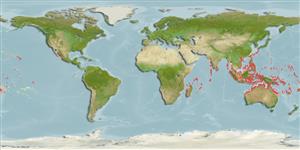Common names from other countries
>
Gobiiformes (Gobies) >
Gobiidae (Gobies) > Gobiinae
Etymology: Priolepis: Greek, prio = to saw + Greek,lepis = scale (Ref. 45335); inhaca: Named for its type locality, Inhaca Island, Mozambique (Ref. 10753).
More on author: Smith.
Environment: milieu / climate zone / depth range / distribution range
Écologie
marin récifal; non migrateur; profondeur 12 - 26 m (Ref. 1602). Tropical; 30°N - 27°S
Indo-Pacific: East Africa to Taiwan and the Society Islands.
Taille / Poids / Âge
Maturity: Lm ? range ? - ? cm
Max length : 4.0 cm TL mâle / non sexé; (Ref. 2798)
Description synthétique
Clés d'identification | Morphologie | Morphométrie
Épines dorsales (Total) : 7; Rayons mous dorsaux (Total) : 9 - 10; Épines anales: 1; Rayons mous anaux: 8. This species has a few, relatively narrow (less than pupil diameter) light bars on the head (Ref. 37816); characterized by pinkish grey with dark brown scale edges forming a network; presence of three pale vertical lines below eye and interconnected pale lines on top of head; absence of pelvic frenum; longitudinal scale series 26-28; predorsal scales 12-17; ctenoid body scales; cycloid scales on pectoral fin base, breast and midlaterally on abdomen; opercle of adult with cycloid scales; predorsal scales absent; posterior edge of tubular posterior nostril adherent to edge of orbit; cheek with single vertical row of papillae; depth of body 4.0 in SL (Ref. 90102).
Has been collected from lagoons and drop-offs (Ref. 1602). Also found in reef crevices (Ref. 90102).
Life cycle and mating behavior
Maturities | Reproduction | Spawnings | Egg(s) | Fecundities | Larves
Hoese, D.F., 1986. Gobiidae. p. 774-807. In M.M. Smith and P.C. Heemstra (eds.) Smiths' sea fishes. Springer-Verlag, Berlin. (Ref. 2798)
Statut dans la liste rouge de l'IUCN (Ref. 130435)
CITES (Ref. 128078)
Not Evaluated
Menace pour l'homme
Harmless
Utilisations par l'homme
Outils
Articles particuliers
Télécharger en XML
Sources Internet
Estimates based on models
Preferred temperature (Ref.
115969): 25.2 - 28.9, mean 27.7 (based on 214 cells).
Phylogenetic diversity index (Ref.
82804): PD
50 = 0.5000 [Uniqueness, from 0.5 = low to 2.0 = high].
Bayesian length-weight: a=0.01023 (0.00477 - 0.02194), b=3.02 (2.84 - 3.20), in cm Total Length, based on LWR estimates for this (Sub)family-body shape (Ref.
93245).
Niveau trophique (Ref.
69278): 3.1 ±0.3 se; based on size and trophs of closest relatives
Résilience (Ref.
120179): Haut, temps minimum de doublement de population inférieur à 15 mois (Preliminary K or Fecundity.).
Fishing Vulnerability (Ref.
59153): Low vulnerability (10 of 100).
